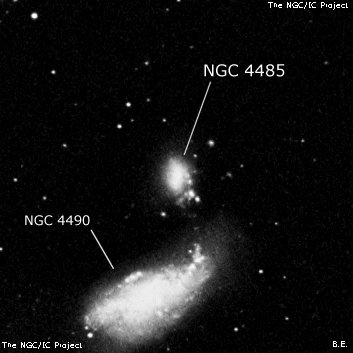
William Herschel discovered NGC 4485 = H I-197 = h1306 on 14 Jan 1788 (sweep 798) and recorded "Two, the most south [NGC 4490] vB, vL, iE. That to the north B, pS, iF, about 1 1/2' distance." JH logged "S; R; is 70° np and 3' n of I. 198 [NGC 4490]."
R.J. Mitchell's sketch with the 72" on 27 Mar 1856 shows a bright nucleus and a well defined outer ring. The following year, though, he could not see any sign of spirality. In addition, a small patch (HII region) is sketched on the south side as well as a faint star, that's probably also a compact HII region.
300/350mm - 13.1" (2/16/85): moderately bright, fairly small, brighter core, elongated SSW-NNE. Forms a fascinating interacting pair with NGC 4490 3.6' SSE of center. Located 40' NW of Beta Canum Venaticorum (V = 4.3). Member of the CVn II Group (brightest member M106).
400/500mm - 18" (6/13/07): moderately bright, moderately large, elongated 4:3 ~N-S, ~1.6'x1.2', broad mild concentration. Extended in the direction of the northwest arm structure in NGC 4490.
600/800mm - 24" (5/27/17): at 200x; moderately to fairly bright, moderately large, elongated 5:4 N-S, ~1.5'x1.2'. Contains a very small brighter core/nucleus but not strongly concentrated. The surface brightness is fairly high and patchy, but I didn't use high power to look for HII regions.
900/1200mm - 48" (5/1/19): at 375x; two obvious HII knots are just off the SW side of this bright galaxy. [VS65] 04, 39" from center, is a bright knot ~12" diameter. [VS65] 01, a slightly fainter knot only 6" diameter, is just 15" further SW. These designations are from 1965 study of HII regions in NGC 2403, 2903 and 4485/4490 by Véron and Sauvayre.
Notes by Steve Gottlieb